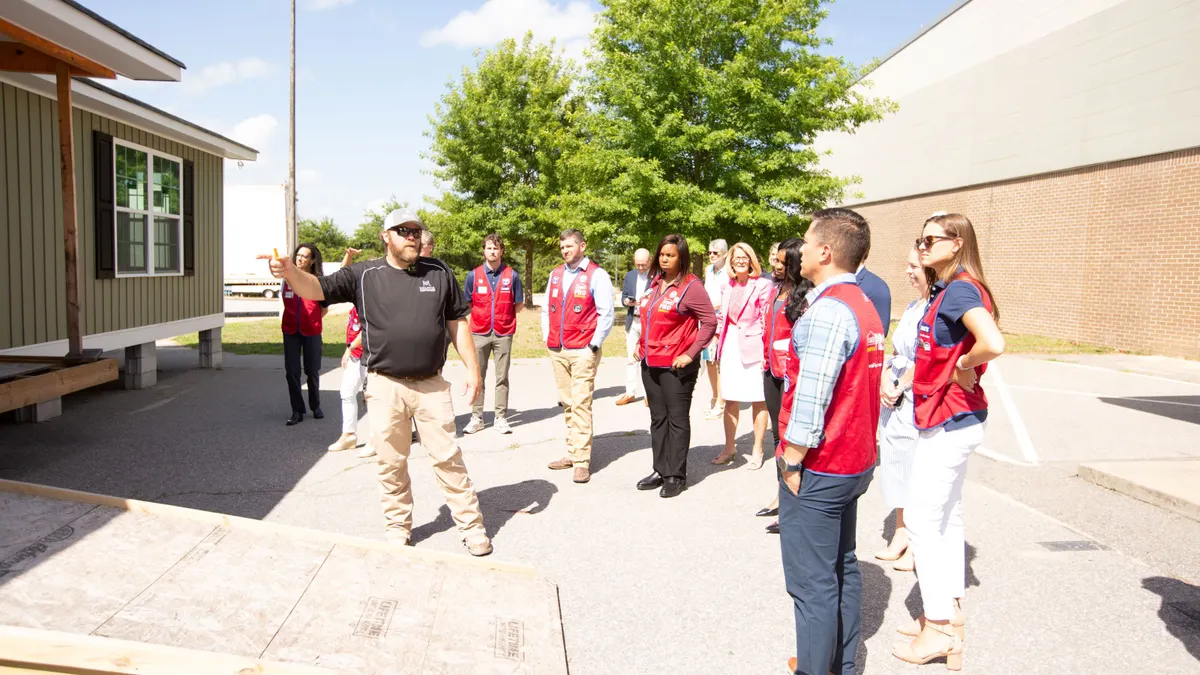In construction, the narrative around labor most often focuses on how employers cannot find the staff to deliver projects.
In the summer of 2024, the opposite was true for Robbie Sharpe. In his case, he had more potential future construction workers than he could train.
As the building construction program director at Midlands Technical College in Columbia, South Carolina, Sharpe said he had to turn away student applicants because he had no more space to train anyone. The program educates students in cohorts by building single-family homes, then sells the structures and uses the funds for future iterations.
When representatives from the Lowe’s Foundation heard about the demand for Sharpe’s program, they penned a $1 million grant for Sharpe’s program.
That allowed him to hire a fourth full-time instructor and increase enrollment options.
“At any given semester, we can take in 48 students,” Sharpe told Construction Dive. “We used to be 24. So we doubled our capacities off of that, and it looks like it's going to grow even further.”
Midlands Technical College is one example of outreach by the Lowe’s Foundation, which in 2023 pledged to donate $50 million across five years to reach 50,000 individuals seeking careers in the skilled trades, Foundation Director Betsy Conway told Construction Dive. To date, the nonprofit has donated $43 million to 60 different technical schools, Conway said.
Creativity in developing programs has improved immensely, Conway said, with hands-on experiences like those Sharpe provides better preparing workers for the trade workforce.
Outreach and ambition
Part of the challenge for some trade schools is their regional footprint, especially in more rural areas, Conway said. To counteract that, the foundation has helped fund groups that provide boots-on-the-ground outreach.
“In Montana, that's a great example. You've got individuals who are really interested in being in the field, but they're hours away from their local community college,” Conway said.
The foundation’s Gable Grants program helps support mobile unit outreach to meet potential tradesworkers where they are and start their training, as opposed to requiring every student to commute to campus.
Conway said Sharpe’s problem with a lack of space for training isn’t unique: she’s seen waitlists at every school the foundation has partnered with.
Formerly a high school teacher, Sharpe says he’s experienced the emergence of the “toolbelt generation,” as attitudes around career focus and higher education shift.
“Somewhere around seven, eight years ago, you saw this change in mindset. We had started to make some ground, breaking that stigma and that stereotype,” Sharpe said. “Now you've got a lot of these students that are like, ‘Yeah, why am I going to go spend all this money on a four year degree when the return on investment's so much better in these trade areas?’”
Commercial and residential
Though Sharpe’s students finish their certification by constructing a house, he says they’re given the tools to pursue careers in nonresidential construction as well. Currently, he estimates about 40% of the graduates end up on commercial jobsites.
Conway confirmed that is true for the majority of the supported groups.
“They're kind of moving back and forth throughout their career,” Conway said. “It really just varies on the community where the training is happening and where the jobs are. But in most cases, the jobs are in both areas. They're able to use those transferable skills kind of back and forth.”
Even still, to better capitalize on the emerging, newly trained workforce, Conway and Sharpe suggested nonresidential builders get involved. Contributing by sitting on an advisory board, for example, can be a key way to not only contribute to the training programs, but benefit from them.
In Sharpe’s experience, home builders that participate in an advisory committee get their pick of the litter when new students graduate.
“It is definitely advantageous for any of these contractors that are looking for employees to reach out not only to their technical colleges, but to their career centers, their high schools and ask to be a part of their advisory committee,” Sharpe said.














